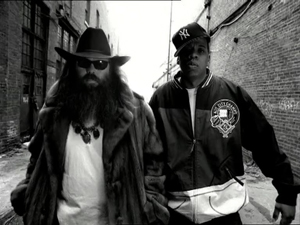Genre Characteristics
Their costumes kept with the characteristics of the hip-hop genre music video as they all had the "gangsta" street look which helped to show that they were from a rougher neighbourhood. They also were seen getting in trouble with the police and were involved in criminal activity; exactly what is typically found in a the hip-hop genre, for example, scenes of dog fighting in a underground club (gambling illegally is thought to be typical for this genre). There were people doing hip-hop and street dance adding to what makes the music video fit in with the genre it is trying to portray. The video lacked representations of wealth, for example, cars were normal, clothing was scruffy, the image of 'bling' appeared minimal, it seemed like Jay-Z didn't have all the riches but was looking at it, possibly connoting that he is either going to steal or will one day have them from his own earning. There were some images of sexualised women, for example, gold bikinis, many looked like prostitutes) but not as many as you might expect there to be for a hip-hop music video. The setting is stereotypical for the hip-hop genre, it's urban in Brooklyn, New York, in a run-down neighbourhood. The video had many representations of a "gangsta" lifestyle i.e. images of underground, rough-looking clubs, and the shooting at the end of the video, it reflects the image of 'gangsta cool'. There were stereotypical race representations, for example, there was a white man in a suit, the policemen shown were white whereas the black people were shown as jailbirds and on the streets involved in crimes.
Lyrics and Visuals
The song is about being a "gangsta" and having that kind of lifestyle, this is exactly what the video images illustrate. There is a synchronous relationship, throughout the song the images reflect the lyrics, sometimes generally and sometimes more specifically/literally, for example, 'God' showed the image of a crucifix, 'bitch' showed an image of women/dog etc. The story about getting pulled over by the police is literally illustrated through the visuals, it has a very narrative style. The visuals show some of the "99 Problems", the pinnacle being him getting shot. Other examples of the synchronous relationship include; 'From the Hood', Jay-Z pulls his hood down, 'Paparazzi', the cameras flash but at images of criminal identity not celebrities.
Music and Visuals
The camera movements are jerky and constant which matches the rise and fall of the beat. The cuts are in sync with the bass, especially at the beginning. There are lots of cuts and many different images which make it hard to see everything on the first viewing, this is similar to the song which is also dense with themes/imagery/narratives.
Demands of the Record Label
There are lots of low angle and close-up shots of Jay-Z which makes him appear powerful, a desirable image to promote within the hip-hop industry. There are fewer shots of him than you might expect, it seems like he's being modest or that he's the 'top dog'/elusive on the streets. Also, it reflects facts that he is a well established artist and doesn't need his face all over the video.
Notions of looking
They look at the police through the wing mirror, this could possibly connote that they do have something to hide, probably something illegal, and are very suspicious characters. There are various shots of women which are very sexualised, this is common in hip-hop videos, for example a woman walking and the shot is just of her bare legs wearing knee-high leather boots hinting at prostitution. There are shots where it looks through the bars into the prison, connoting that the criminal activity he is involved in may have him ending up there. There was a video of Jay-Z showing outside the subway station, which contradicts his life in the 'hood' as it makes him seem famous and that there is no need for him to be still involved with his life there. There was an x-ray vision shot through the boot of Jay-Z's car which had an illegal dog in a cage in, this allowed the viewer to feel a closer connection to the video as they knew what the secret was before the police.
Intertextual References
He gets shot at the end of the song multiple times and the way he fell links to any kind of action film. It's shot in only black and white which could be a reference to other gangster movies. Rick Rubin appears in the video who is actually a music producer and has helped to produce Jay-Z's music videos.
He gets shot at the end of the song multiple times and the way he fell links to any kind of action film. It's shot in only black and white which could be a reference to other gangster movies. Rick Rubin appears in the video who is actually a music producer and has helped to produce Jay-Z's music videos.

No comments:
Post a Comment